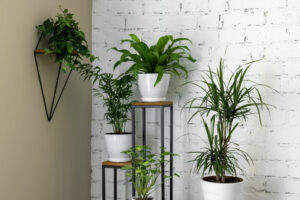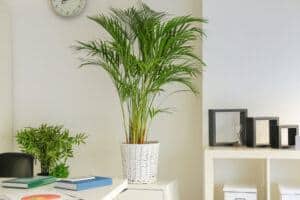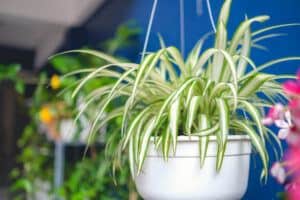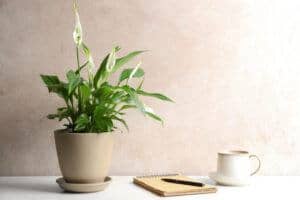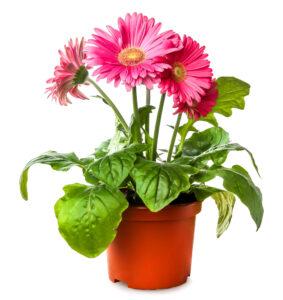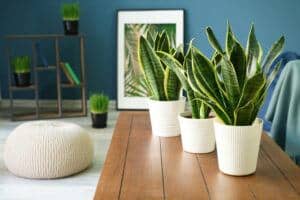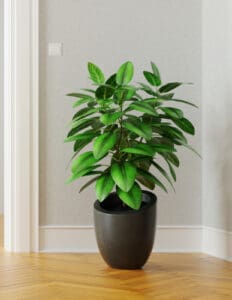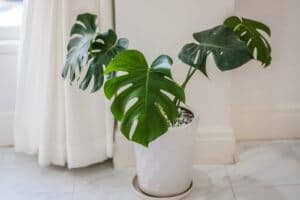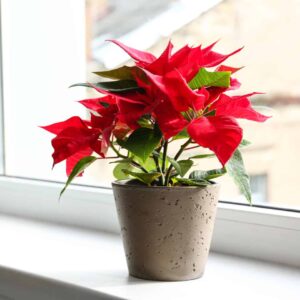HousePlantJoy is supported by our audience. When you purchase through one of our links, we may earn a small affiliate commission. As an Amazon Associate I earn from qualifying purchases. Your cost is not affected.
==================
Air-Purifying Houseplants: They’re not just your home’s green companions; they’re like the unsung heroes of your living space. While we all adore indoor plants for the touch of nature they bring to our homes, these leafy companions do more than just sit pretty. They’re your silent partners in creating a healthier and more vibrant indoor environment.
Imagine having your own little squad of botanical bodyguards that work tirelessly to cleanse the air you breathe, reduce toxins, and maintain the perfect humidity levels. It’s like having your very own team of superheroes, but instead of capes, they wear leaves.
In this journey through the world of air-purifying houseplants, we’ll introduce you to a dozen remarkable species that not only add aesthetic charm to your space but also contribute to a cleaner, more peaceful, and healthier home. So, if you’re ready to dive into the world of indoor gardening and discover the incredible benefits of these natural air purifiers, keep reading. Your indoor oasis awaits.
Key Takeaways:
- Air-purifying houseplants offer a combination of aesthetic appeal and the ability to improve indoor air quality by removing common pollutants.
- Scientific studies support their air-purifying capabilities, making them valuable additions to indoor spaces.
- Carefully chosen plants like Spider Plants, Peace Lilies, and Pothos are easy to maintain and effective at filtering out harmful indoor pollutants.
- Ensure proper placement, lighting, and watering practices to keep these plants healthy and thriving.
- Enjoy the beauty of these houseplants while they work their magic to create a healthier and more inviting indoor environment.
Air-Purifying Houseplants: Your Guide to the Top 12 Varieties for a Healthier Home
You know what’s fantastic about indoor plants? They don’t just spruce up our living spaces; they’re like Mother Nature’s little cleaning crew. Seriously, they’re the unsung heroes of your home. You see, these green pals do more than just look pretty; they’re like the invisible housekeepers that make your indoor environment healthier and more welcoming.
So, here’s the scoop: indoor plants aren’t just there for decoration. They’re oxygen factories, churning out that sweet, life-giving gas we all need to breathe. And here’s the cool part – they take the carbon dioxide we exhale and turn it into fresh, oxygenated air. It’s like a botanical breath of fresh air.
But wait, there’s more! Our homes aren’t exactly free of troublemakers. We’ve got sneaky toxins like formaldehyde, xylene, toluene, benzene, and trichloroethylene lurking around, courtesy of our furniture, building materials, detergents, and cleaning products. And that’s where our leafy friends come to the rescue. They’re like the natural detoxifiers of your home, filtering out these nasty chemicals, reducing mold’s mischievous growth, maintaining just the right humidity, and creating a stress-free haven. It’s like having your own little spa day, right in your living room.
How Are Houseplants Discover As Air-Purifying?
While houseplants decorated homes for many years, the discovery of their health benefits came more recently. B.C. “Bill” Wolverton first discovered the ability of plants to clean heavy toxins such as Agent Orange in the Florida swamps. That led to further research, where he demonstrated the unique ability of plants to clean air toxins. While he initially researched to aid NASA space exploration, it also translated to our homes! You can read more about his work and findings here; his book is also available on Amazon!
As his research continued, he discovered that some plants perform this air cleaning much more efficiently than others. While you may choose plants other than the top performers, you might ensure you have at least a few top performers.
For a distinct touch in showcasing your beloved houseplants, explore the charming selection of pots we’ve uncovered. #ads #commissionsearned
12 Types of Air-Purifying Houseplants
There are too many houseplants, but here are the 12 types of air-purifying houseplants that will help purify your home’s air. Fascinating right? So keep reading as we amaze you how these houseplants help.
Areca Palm
The Areca Palm filters toxins from home like a powerhouse. It targets benzene, carbon dioxide, toluene, and formaldehyde in the air. These chemicals accumulate in the air when we use detergents, nail varnish, furniture, etc. Four shoulder-high plants of the Areca Palm plant will usually offer one person unpolluted air. This plant is also a good choice if you have pets, as it is non-toxic. Areca palm grows best in filtered light with plenty of water.
Areca Palm Care:
- Light: Provide bright, filtered light; avoid direct sun.
- Temperature: Maintain temperatures between 65°F to 75°F (18°C to 24°C).
- Watering: Keep soil consistently moist but not waterlogged; water when the top inch of soil is dry.
- Humidity: Maintain higher humidity levels through trays or a room humidifier.
- Fertilization: Use balanced, water-soluble fertilizer during the growing season.
- Pruning: Regularly remove dead or yellowing fronds.
- Repotting: Repot every 2-3 years or when the plant becomes root-bound.
- Pests and Diseases: Watch for spider mites and scale insects; treat promptly if needed.
- Pet-Friendly: Safe for homes with pets.
Spider Plant
If you desire to purify your environment with little effort, the spider plant is for you. It works like a sponge to absorb chemicals from the air, such as carbon dioxide, formaldehyde, and benzene. It removes about 90% of indoor toxins in just two days. Moreover, it’s a generous plant of a mother’s nature, always teaching us to give and share. This plant produces baby spider plants that can be easily cut off to grow in soil or water to make your plant’s family. While the Spider Plant gives you multiple benefits, it doesn’t demand much from you. The occasional watering keeps it quite happy.
Spider Plant Care:
- Air Purification: Spider Plants are effective at removing indoor toxins like carbon dioxide, formaldehyde, and benzene.
- Propagation: They produce “baby” plants (spiderettes) that can be cut and replanted, expanding your plant family.
- Light: Thrive in bright, indirect light but can tolerate lower light conditions.
- Watering: Keep the soil evenly moist, but not soggy. Allow the top inch of soil to dry before watering.
- Temperature: Ideal temperatures range from 65°F to 75°F (18°C to 24°C). They can tolerate slightly cooler conditions.
- Fertilization: Feed with a balanced, water-soluble fertilizer during the growing season (spring and summer), about every 2-4 weeks.
- Potting: Repot occasionally, when the plant becomes root-bound or outgrows its container.
- Pests and Diseases: Generally pest-resistant but watch for spider mites and mealybugs. Treat if needed.
Chinese Evergreen Houseplant
The uniqueness of the Chinese Evergreen lies in its variegated leaves. It’s considered very popular among house plants with attractive white blooms and red berries. As it releases oxygen, the Chinese Evergreen reduces pollutants, providing a healthful milieu and reducing respiratory sickness.
It prefers low light and well-drained soil. Mist it frequently if your home is not in high humidity. Try growing this houseplant; it does not require too much time for you.
Chinese Evergreen Care:
- Aesthetic Appeal: Chinese Evergreens have variegated leaves, attractive white blooms, and red berries.
- Air Purification: This plant releases oxygen and helps reduce indoor pollutants, promoting a healthier environment.
- Light: Prefers low to moderate indirect light, making it suitable for various indoor spaces.
- Soil: Well-draining potting mix is essential to prevent waterlogged roots.
- Humidity: If your home is not naturally humid, mist the plant occasionally to maintain a higher humidity level.
- Watering: Keep the soil consistently lightly moist but not soggy. Allow the top inch of soil to dry between waterings.
- Fertilization: Feed with a balanced, water-soluble fertilizer during the growing season, usually every 4-6 weeks.
- Temperature: Chinese Evergreens thrive at typical indoor temperatures ranging from 65°F to 75°F (18°C to 24°C).
- Pruning: Trim or remove damaged or yellowing leaves to encourage healthy growth.
Peace Lily Houseplant
A Peace Lily can be a gorgeous addition to your side table. The glossy green leaves and pretty white flowers catch everybody’s attention. This good-looking plant works exceptionally well as an air cleaner. It cleans the air from VOCs (volatile organic compounds). In addition, it absorbs mold spores, thereby helping to sustain a mold-free state. The Peace Lily loves humidity. As such, it grows well in the bathroom, where it also reduces mold growth on tiles and curtains as well.
Peace Lily Care:
- Aesthetic Appeal: Features glossy green leaves and elegant white flowers, making it a visually striking addition to your indoor space.
- Air Purification: Excellent at removing volatile organic compounds (VOCs) from the air, promoting cleaner indoor air quality.
- Humidity Lover: Thrives in high humidity environments and is particularly well-suited for bathrooms, where it can reduce mold growth on tiles and curtains.
- Light: Prefers bright, indirect light, but it can tolerate lower light conditions.
- Watering: Keep the soil consistently moist, but avoid overwatering. Water when the top inch of soil is dry.
- Fertilization: Feed with a balanced, water-soluble fertilizer during the growing season (spring and summer) every 4-6 weeks.
- Temperature: Thrives in temperatures between 65°F to 80°F (18°C to 27°C).
- Pruning: Trim or remove spent flowers and yellowing leaves to maintain its attractive appearance.
- Potting: Repot occasionally, as needed, when the plant becomes root-bound.
Gerbera Daisy
The Gerbera Daisy flowers grow in a range of colors. Many believe the colors of the daisy indicate feelings. The red daisies express inspiration, pink conveys gratitude, bright orange for happiness, and white symbolizes purity. Like other plants, Gerbera Daisies produce oxygen, absorbing carbon dioxide and other toxins. Please place it in your bedroom. It will enhance your mood and help you sleep better.
Gerbera Daisy Care:
- Color Variety: Gerbera Daisy flowers come in a wide range of colors, and each color is often associated with different emotions. For example, red expresses inspiration, pink conveys gratitude, bright orange symbolizes happiness, and white represents purity.
- Air Purification: Like many other plants, Gerbera Daisies produce oxygen and can help absorb carbon dioxide and toxins from the air.
- Bedroom Enhancement: Placing a Gerbera Daisy in your bedroom can enhance your mood with its vibrant colors and potentially contribute to better sleep quality by improving air quality.
- Light: Gerbera Daisies prefer bright, indirect light. They need several hours of sunlight each day to thrive.
- Watering: Keep the soil evenly moist but not waterlogged. Allow the top inch of soil to dry before watering.
- Temperature: Maintain a temperature range between 65°F to 75°F (18°C to 24°C) for optimal growth.
- Fertilization: Feed with a balanced, water-soluble fertilizer during the growing season (spring and summer) every 2-4 weeks.
- Deadheading: Remove spent flowers to encourage continuous blooming.
Snake Houseplant
The Snake Plant possesses the unique character of providing oxygen at night. Keep a snake plant in your bedroom. It works silently when you sleep, converting much carbon dioxide into oxygen. Also known as a Mother-In-Law’s Tongue, the snake plant in your bathroom filters formaldehyde that usually occurs in tissue papers and air fresheners. It diminishes airborne allergens, too. About 6 to 8 snake plants can provide enough oxygen for a person’s health in a small room. The Snake plant doesn’t demand much care. It gladly filters the air for you even after weeks of neglect.
English Ivy
The English Ivy displays its vines well in a hanging basket or trellis. While it makes an ideal houseplant grown outdoors, it readily climbs the sides of buildings and fences. Beneficial for people with breathing problems, English Ivy absorbs airborne matter, reduces mold growth, and removes benzene. It possesses anti-inflammatory properties that reduce swelling of the respiratory tract. Additionally, it contributes to the protection of your lungs, spleen, and liver. To care for your ivy, keep it in a shaded area and train it into your desired shape.
Snake Plant Care:
- Oxygen Production: A distinctive feature of the Snake Plant is its ability to produce oxygen at night, making it an excellent choice for the bedroom, where it silently converts carbon dioxide into oxygen, potentially promoting better sleep.
- Air Purification: This plant is effective at filtering out formaldehyde, which can be found in tissue papers and air fresheners. It also helps reduce airborne allergens.
- Quantity for Oxygen: About 6 to 8 Snake Plants can provide enough oxygen for one person’s health in a small room.
- Low Maintenance: The Snake Plant is known for its resilience and ability to thrive with minimal care. It can tolerate neglect and still perform its air-purifying functions effectively.
- Light: Prefers indirect light but can adapt to various lighting conditions, including low light.
- Watering: Allow the soil to dry out between waterings. Overwatering should be avoided, as Snake Plants are susceptible to root rot.
- Temperature: Thrives at typical indoor temperatures, ranging from 60°F to 75°F (15°C to 24°C).
- Pest Resistance: Generally pest-resistant, making it a low-maintenance choice.
Rubber Plant
The burgundy glossy leaves of this evergreen plant provide oxygen in exchange for the carbon dioxide we exhale. The Rubber Plant also breaks down other toxins, such as benzene and formaldehyde. Indeed, it reduces the growth of bacterial and mold spores. To keep this air-purifying houseplant healthy, keep it in indirect light and water occasionally in winter and weekly in summer. Avoid over-watering. They do not just purify the air in your home but add beauty, too.
Rubber Plant Care:
- Air Purification: Rubber Plants release oxygen and help reduce carbon dioxide levels. They also break down toxins such as benzene and formaldehyde in the air. Additionally, they can reduce the growth of bacterial and mold spores.
- Light: Place your Rubber Plant in indirect, bright light. They can tolerate some direct sunlight but may scorch if exposed to it for extended periods.
- Watering: In winter, water the plant occasionally, allowing the soil to dry slightly between waterings. In the summer, increase the frequency to about once a week. Avoid overwatering, as they are susceptible to root rot.
- Temperature: Rubber Plants prefer temperatures between 60°F to 75°F (15°C to 24°C) and can tolerate slightly cooler conditions.
- Fertilization: Feed with a balanced, water-soluble fertilizer during the growing season (spring and summer) every 4-6 weeks.
- Pruning: Prune to shape the plant and remove any damaged or yellowing leaves.
- Pest Resistance: While they can be susceptible to pests like mealybugs and spider mites, they are relatively pest-resistant.
Philodendrons Houseplant
A luscious addition to a high shelf or floor space, the Philodendron adds texture to your decor. In favorable conditions, it can grow up to 15 feet. It targets formaldehyde (from furniture, building materials, carpets, etc.) in the air. These heart-shaped veiny plants come in a range of sizes and colors. Displaying hearty leaves that look pretty cool, Philodendrons contain toxins. Therefore, these beautiful plants are dangerous for children or pets.
However, those choosing to keep them need only find the same place to avoid the dangers. The Philodendron dislikes direct sunlight. Also, don’t over or underwater your philodendrons. For best success, water it when the soil seems dry.
Philodendron Care:
- Decorative Appeal: Philodendrons add texture and aesthetic value to your decor, and they can grow impressively tall in favorable conditions, up to 15 feet.
- Air Purification: They are effective at targeting and removing formaldehyde from the air, which is often found in furniture, building materials, carpets, and more.
- Variety: Philodendrons come in a range of sizes and colors, with heart-shaped, veined leaves that create an attractive display.
- Toxicity: Philodendrons contain toxins that can be harmful to children and pets if ingested. It’s crucial to keep them out of reach to avoid potential dangers.
- Light: They prefer bright, indirect light and should be protected from direct sunlight, which can scorch their leaves.
- Watering: It’s essential not to overwater or underwater your Philodendron. Water it when the top inch of soil feels dry to the touch. They are relatively forgiving if you allow the soil to dry slightly between waterings.
Pothos
Pothos is a high-rated air cleanser. It removes many dangerous chemicals that may affect your health. Pothos plants help free the environment from formaldehyde, benzene, toluene, and xylene. It can extend up to 10ft. Although the Pothos prefer cascading hanging baskets, they grow well on a tabletop. The trailing vines look amazing over the edges of the table display.
Moreover, its forgiving nature allows most people to keep it accessible. It will survive with some neglect. However, it thrives best with some weekly attention.
Pothos Care:
- Air Purification: Pothos is known for its air-cleansing capabilities, effectively removing dangerous chemicals such as formaldehyde, benzene, toluene, and xylene.
- Versatile Growth: Pothos vines can extend up to 10 feet, making them suitable for cascading hanging baskets or tabletop displays.
- Low Maintenance: Pothos is forgiving and can thrive with minimal care, making it an ideal choice for beginners. It can tolerate some neglect but benefits from weekly attention.
- Light: While adaptable to various lighting conditions, Pothos thrives in indirect light and can tolerate low light. Avoid direct sun, which can scorch the leaves.
- Watering: Allow the soil to dry between waterings. Overwatering should be avoided, as it can lead to root rot.
- Temperature: Pothos prefer temperatures between 60°F to 80°F (15°C to 27°C).
- Fertilization: Feed with a balanced, water-soluble fertilizer during the growing season (spring and summer) every 4-6 weeks.
Boston Fern
A well-known favorite air-purifying houseplant, the Boston Fern loves humidity. It serves as a small humidifier, keeping your home’s moisture level. Place Boston ferns in an air-conditioned room as it thrives well at low temperatures. This leafy workhorse removes contaminants such as formaldehyde. It displays beautifully in a tabletop planter. However, the Boston Fern shows equally well in a hanging basket. I would like to remind you to mist it regularly. While many plants don’t like their leaves wet, the Boston Fern requires it.
Boston Fern Care:
- Air Purification: Boston Ferns are well-known for their air-purifying qualities, effectively removing contaminants like formaldehyde from the air.
- Humidity Lover: These ferns thrive in high humidity environments and serve as small humidifiers, contributing to moisture levels in your home.
- Temperature: They thrive at lower temperatures and are well-suited for air-conditioned rooms. Ideal temperature ranges from 60°F to 75°F (15°C to 24°C).
- Display Options: Boston Ferns can be showcased in tabletop planters or hanging baskets, making them versatile for various indoor spaces.
- Misting: Regular misting is essential to maintain the required humidity level for Boston Ferns. Unlike many plants, these ferns prefer their leaves to be kept moist.
- Light: Place them in bright, indirect light, away from direct sun, which can damage their delicate fronds.
- Watering: Keep the soil consistently moist but not waterlogged. They may need more frequent watering in dry conditions.
- Fertilization: Feed with a balanced, water-soluble fertilizer during the growing season (spring and summer) about every 6-8 weeks.
Poinsettia
Known as a Christmas plant, the Poinsettia also serves as an air-purifying houseplant. It cleans the house’s air while providing color and interest. It removes chemicals and molds from your home. However, Poinsettia is toxic. Therefore, you must ensure that children and pets cannot reach them. Its beautiful bracts and lovely flowers will brighten your bedroom’s corner. Sunlight and well-drained soil allow these plants to thrive.
Poinsettia Care Summary:
- Air Purification: Poinsettias serve as air-purifying houseplants, effectively removing chemicals and molds from your indoor environment.
- Toxicity: It’s important to note that Poinsettias are toxic to both children and pets. Therefore, they must be placed out of reach to prevent any accidental ingestion.
- Decorative Appeal: Poinsettias are known for their vibrant bracts (colored leaves) and lovely flowers, which can brighten up corners of your home.
- Light: These plants require bright, indirect light to thrive. Avoid direct sunlight, which can damage the leaves.
- Watering: Keep the soil consistently moist but not waterlogged. Poinsettias are sensitive to overwatering, so allow the top inch of soil to dry before watering again.
- Temperature: Poinsettias prefer temperatures between 65°F to 70°F (18°C to 21°C).
- Fertilization: Feed with a balanced, water-soluble fertilizer every 4-6 weeks during the growing season (spring and summer).
Air-Purifying Houseplants: Your Green Allies for Cleaner Air
As we wrap up our exploration of air-purifying houseplants, let’s give a shoutout to our green companions: Areca Palm, Spider Plant, Chinese Evergreen, Peace Lily, Snake Plant, Rubber Plant, Philodendron, Pothos, Boston Fern, and Poinsettia. These carefully chosen plants are more than just decorative elements; they are nature’s solution to indoor air quality. Backed by scientific studies and research, they’ve earned their place in our homes for their exceptional ability to filter out common indoor pollutants, such as formaldehyde and benzene. With their low-maintenance charm and proven air-purifying prowess, they make your living spaces more comfortable, healthful, and inviting. So, bring the beauty of these plants into your home and let them work their magic in creating a fresher and more delightful atmosphere.
Once more, elevate your houseplant presentation with our handpicked collection of pots. #ads #commissionsearned
Air-Purifying Houseplants: 12 Breath-Freshening Beauties for Your Home
Alright, it’s time to wrap up our journey through the world of air-purifying houseplants. We’ve introduced you to a dozen amazing green friends, but here’s the deal – the plant kingdom is vast, and there are plenty more out there waiting to be your air-purifying companions.
But it’s not just about cleaner air; it’s about embracing the health and tranquility these leafy heroes bring to your life. They’re like a refreshing forest walk, right in the comfort of your own home.
This isn’t a secret known only to us; the pros in the office, shopping malls, and restaurants have clued into this, too. They’ve incorporated these green gems into their spaces, not just for the aesthetics but also for the ambiance they create.
So, which plants are you going to pick? We’re all ears and excited to hear about your favorites and how they’re transforming your space into a greener, healthier haven. Happy planting!
Frequently Asked Questions
FAQ 1: How do I choose the right air-purifying houseplant for my home?
The best plant for you depends on your space and preferences. Consider factors like available light, the level of care you’re willing to provide, and any specific pollutants you want to target. Our article highlights ten popular options to get you started.
Are air-purifying houseplants safe for homes with pets and children?
While these plants are great for cleaning the air, some of them, like Pothos and Philodendron, can be toxic if ingested. So, keep them out of reach or opt for pet-friendly options like Spider Plants or Areca Palms.
How often should I water my air-purifying houseplants?
The watering frequency depends on the specific plant and environmental conditions, but generally, allow the top inch of soil to dry before watering. In the growing season, most plants benefit from regular watering, while they may require less in winter.
Can I use air-purifying houseplants in my bedroom to help me sleep better?
Absolutely! Plants like the Snake Plant and Peace Lily are excellent choices for the bedroom. They release oxygen at night and can contribute to better sleep. Just make sure they get enough indirect light during the day to thrive.
Join the Houseplant Community! ?
Explore inspiring content, insightful product reviews, and connect with fellow houseplant enthusiasts on our social media platforms:
- ? Facebook: Discover tips, tricks, and engage with our passionate community.
- ? Instagram: See stunning plant photos, share your own, and be part of the conversation.
- ? Pinterest: Find boards full of plant care guides, ideas, and more.
- ? Twitter: Stay updated, share your love for houseplants, and connect with like-minded enthusiasts.
Plus, don’t miss out on our newsletter for exclusive content, plant care secrets, and exciting updates! ??



